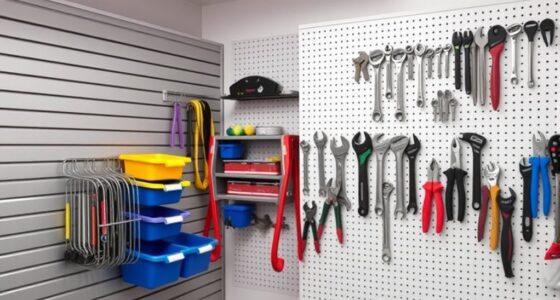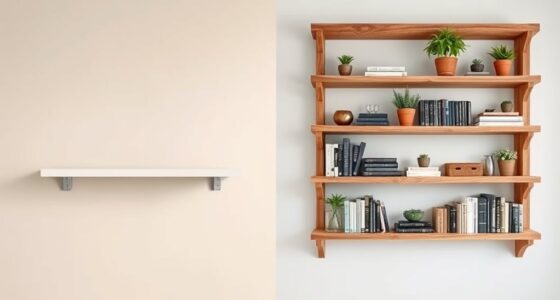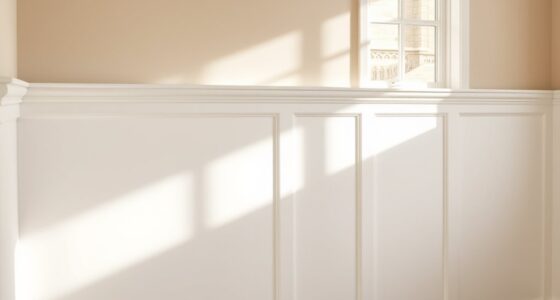To install a backsplash yourself, start by measuring the area accurately and planning your layout. Choose between traditional tiles with mortar or peel-and-stick options for easier application. Gather necessary tools like a notched trowel, spacers, tile cutter, level, and safety gear. Prepare your surface, mark cut lines, and carefully place each tile, ensuring proper alignment. Finish by grouting, cleaning excess material, and sealing for durability—continue exploring to master each step confidently.
Key Takeaways
- Measure your backsplash area accurately to determine tile quantity and layout before starting installation.
- Choose between peel-and-stick or traditional tile methods based on your skill level and project needs.
- Prepare the surface by cleaning and leveling to ensure proper adhesion and alignment.
- Use spacers and a level during installation for uniform gaps and straight lines.
- Allow adhesive to cure fully, then apply grout, wipe excess, and seal for a professional, durable finish.

Installing a backsplash yourself can be a rewarding way to update your kitchen’s look without hiring a professional. With the right tools and materials, you can transform your space on your own, saving money and gaining a satisfying sense of accomplishment. Before you start, gather all necessary supplies. For a simple peel-and-stick project, you’ll need self-adhesive tile mats, pre-mixed grout, a grout float, sponge, spacers, and a utility blade. These materials make the process more straightforward and are perfect for quick updates. If you’re going for a traditional tile look, you’ll want a notched trowel to spread mortar or adhesive evenly, tile spacers to keep your tiles aligned and spaced correctly, and a grout float for applying grout smoothly. Measuring tools are essential too; a measuring tape ensures your tiles fit perfectly, while a level keeps everything straight. For cutting tiles to fit edges or around outlets, you’ll need a utility knife, a tile cutting device like a snap cutter or wet saw, and potentially a pencil for marking cut lines.
Once you have your tools and materials, start by measuring your area carefully. Use a level to draw straight guidelines, ensuring your tiles are aligned properly from the beginning. For peel-and-stick tiles, simply peel off the backing and carefully press the tiles onto your wall following your guidelines. For traditional tiles, spread an even layer of mortar or adhesive using the notched trowel, then place your tiles one by one, pressing firmly and using spacers to maintain uniform gaps. Take your time to check alignment frequently; a level can help you keep everything straight. When it’s time to cut tiles, mark the spots with a pencil, then use your tile cutter or wet saw to make precise cuts. Always wear safety gear when operating cutting tools. It’s also helpful to have a compass or template on hand for consistent, curved cuts around fixtures or outlets.
Additionally, understanding the science behind self-cleaning tiles can help you choose the best materials for a maintenance-free backsplash, ensuring long-term durability and cleanliness. After all your tiles are in place, let the adhesive cure if using traditional tiles. For peel-and-stick tiles, you can usually proceed quickly. Once the tiles are fixed, apply grout using the grout float, pressing it into the joints and wiping away excess with a damp sponge. This step ensures your tiles are sealed and look professional. Some optional tools, like a rubber mallet, can help tap tiles gently into place if needed, and paint might be used for touch-ups around edges. With patience and attention to detail, you can achieve a beautiful, custom backsplash that enhances your kitchen’s style. Doing it yourself not only saves money but also gives you a sense of pride in your handiwork.
Frequently Asked Questions
Can I Install a Backsplash Over Existing Tiles?
Yes, you can install a backsplash over existing tiles if they’re sturdy, well-aligned, and in good condition without cracks or unevenness. Make sure the surface is clean, dry, and flat for proper adhesion. You can choose materials like peel-and-stick tiles, paint, or paneling. Just be aware that layering might affect outlet depths or cabinet clearance, and future removal could be more complicated. Proper preparation guarantees a durable, attractive finish.
What Tools Are Essential for DIY Backsplash Installation?
You’ll need essential tools like a utility knife to cut mesh backing and trim tiles, a tape measure for accurate measurements, and a pencil to mark cuts. For cutting tiles, a wet saw is best for natural stone, while a tile cutter works for ceramic or porcelain. Use a notched trowel to spread adhesive, spacers for even grout lines, and a rubber float for applying grout. Don’t forget safety gear like goggles and gloves.
How Long Does a Typical Backsplash Installation Take?
A typical backsplash installation takes about two days for most DIYers, especially in mid-size to large kitchens. On the first day, you’ll handle tile installation, including cutting, layout, and adhering tiles. The second day involves grouting, sealing, and finishing touches. Smaller projects or simple designs might be done in a day, but larger or more complex ones could take longer. Proper prep and patience guarantee a smooth process and great results.
Are There Eco-Friendly or Sustainable Backsplash Options?
You’re interested in eco-friendly or sustainable backsplash options, and there are plenty to choose from. You can opt for recycled glass tiles, bamboo, or natural stone, all of which reduce environmental impact. Using salvaged or upcycled materials adds a unique, eco-conscious touch. These choices not only help lower your carbon footprint but also promote waste reduction, energy efficiency, and sustainable design, making your kitchen both stylish and environmentally responsible.
How Do I Ensure Proper Waterproofing Behind the Backsplash?
To guarantee proper waterproofing behind your backsplash, start by cleaning the wall thoroughly and repairing any cracks with silicone sealant. Apply a compatible primer to boost adhesion, then use a liquid membrane or sheet waterproof barrier, overlapping seams with sealant. Seal around outlets and joints, and protect edges with masking tape. Regularly inspect and reseal grout or caulk to maintain waterproof integrity over time, preventing moisture damage.
Conclusion
Installing a backsplash yourself can save you money and give your kitchen a fresh look. With proper planning and patience, you can achieve professional results. Did you know that DIY projects like backsplash installation save homeowners an average of 40% on labor costs? So, why not give it a try? With the right tools and a bit of effort, you’ll enjoy the satisfaction of transforming your space—plus, you’ll have a beautiful new backsplash to show off!









